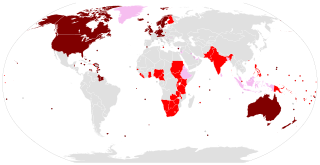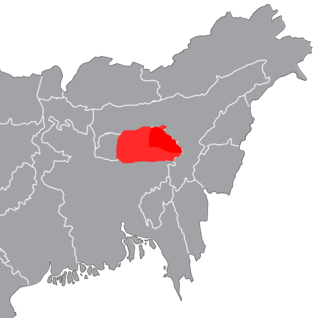Related Research Articles

The Germanic languages are a branch of the Indo-European language family spoken natively by a population of about 515 million people mainly in Europe, North America, Oceania and Southern Africa. The most widely spoken Germanic language, English, is the world's most widely spoken language with an estimated 2 billion speakers. All Germanic languages are derived from Proto-Germanic, spoken in Iron Age Scandinavia.
Hawaiian is a Polynesian language of the Austronesian language family that takes its name from Hawaiʻi, the largest island in the tropical North Pacific archipelago where it developed. Hawaiian, along with English, is an official language of the State of Hawaii. King Kamehameha III established the first Hawaiian-language constitution in 1839 and 1840.
In phonology, minimal pairs are pairs of words or phrases in a particular language, spoken or signed, that differ in only one phonological element, such as a phoneme, toneme or chroneme, and have distinct meanings. They are used to demonstrate that two phones are two separate phonemes in the language.

The Slavic languages, also known as the Slavonic languages, are Indo-European languages spoken primarily by the Slavic peoples or their descendants. They are thought to descend from a proto-language called Proto-Slavic, spoken during the Early Middle Ages, which in turn is thought to have descended from the earlier Proto-Balto-Slavic language, linking the Slavic languages to the Baltic languages in a Balto-Slavic group within the Indo-European family.

Khasi is an Austroasiatic language spoken primarily in Meghalaya state in India by the Khasi people. It is also spoken by a sizeable population in Assam and Bangladesh. Khasi is part of the Austroasiatic language family, and is related to Khmer, Palaung, Vietnamese and Mon languages of Southeast Asia, and the Munda and Nicobarese branches of that family, which are spoken in east–central India and in the Nicobar Islands, respectively.
ǂʼAmkoe, formerly called by the dialectal name ǂHoan, is a severely endangered Kxʼa language of Botswana. West ǂʼAmkoe, Taa, and Gǀui form the core of the Kalahari Basin sprachbund, and share a number of characteristic features, including some of the largest consonant inventories in the world. ǂʼAmkoe was shown to be related to the Juu languages by Honken and Heine (2010), and as a result was classified along with the ǃKung language in the Kxʼa language group.
Atong is a Sino-Tibetan language related to Koch, Rabha, Bodo and Garo. It is spoken in the South Garo Hills and West Khasi Hills districts of Meghalaya state in Northeast India, southern Kamrup district in Assam, and adjacent areas in Bangladesh. The correct spelling "Atong" is based on the way the speakers themselves pronounce the name of their language. There is no glottal stop in the name and it is not a tonal language.

The Khasi people are an indigenous ethnic group of Meghalaya in north-eastern India with a significant population in the bordering state of Assam, and in certain parts of Bangladesh. The Khasi people form the majority of the population of the eastern part of Meghalaya, and is the state's largest community, with around 48% of the population of Meghalaya. They are among the few Austroasiatic-speaking peoples in South Asia. A cultural tradition of the Khasi people is that they follow the matrilineal system of descent and inheritance. Under the Constitution of India, the Khasis have been granted the status of Scheduled Tribe.

The Delaware languages, also known as the Lenape languages, are Munsee and Unami, two closely related languages of the Eastern Algonquian subgroup of the Algonquian language family. Munsee and Unami, spoken aboriginally by the Lenape people in the vicinity of the modern New York City area in the United States, including western Long Island, Manhattan Island, Staten Island, as well as adjacent areas on the mainland: southeastern New York State, eastern Pennsylvania, New Jersey, Connecticut, Maryland, and Delaware.
Sankethi is a South Dravidian language that is closely related to Tamil. It is sometimes considered a dialect of Kannada or Tamil, but there are considerable differences that make it unintelligible to speakers of both languages. It has strong lexical influences from Kannada, as well as Sanskrit.. It is most commonly spoken in Karnataka, India by the Sankethi people, who migrated from Sengottai in Tamilnadu.

The Khasic or Khasian languages are a family of Austroasiatic languages spoken in the northeastern Indian state Meghalaya and neighbouring areas of Bangladesh.
Polish orthography is the system of writing the Polish language. The language is written using the Polish alphabet, which derives from the Latin alphabet, but includes some additional letters with diacritics. The orthography is mostly phonetic, or rather phonemic – the written letters correspond in a consistent manner to the sounds, or rather the phonemes, of spoken Polish. For detailed information about the system of phonemes, see Polish phonology.
Domari is an endangered Indo-Aryan language, spoken by older Dom people scattered across the Middle East and North Africa. The language is reported to be spoken as far north as Azerbaijan and as far south as central Sudan, in Turkey, Iran, Iraq, Palestine, Israel, Jordan, Egypt, Sudan, Libya, Tunisia, Algeria, Morocco, Syria and Lebanon. Based on the systematicity of sound changes, we know with a fair degree of certainty that the names Domari and Romani derive from the Indo-Aryan word ḍom. The language itself actually derives from an Indo-Aryan language. The Arabs referred to them as nawar as they were a nomadic people that originally immigrated to the Middle East from India.

The Mizo language, or Mizo ṭawng, is a Kuki-Chin-Mizo language belonging to the Tibeto-Burman family of languages, spoken natively by the Mizo people in the Mizoram state of India and Chin State in Burma. The language is also known as Duhlian, a colonial term, as the Duhlian people were the first among the Mizos to be encountered by the British in the course of their colonial expansion. The Mizo language is mainly based on Lusei dialect but it has also derived many words from its surrounding Mizo sub-tribes and sub-clan. Now, Mizo language or Mizo ṭawng is the lingua franca of Mizoram and its surrounding areas and to a lesser extent of Burma and Bangladesh and in India in some parts of Assam, Tripura and Manipur. Many poetic language is derived from Pawi, Paite, and Hmar, and most known ancient poems considered to be Mizo are actually in Pawi. Mizo is the official language of Mizoram, along with English, and there have been efforts to have it included in the Eighth Schedule to the Constitution of India.
Garo, or A·chik, is a Sino-Tibetan language spoken in India in the Garo Hills districts of Meghalaya, some parts of Assam, and in small pockets in Tripura. It is also spoken in certain areas of the neighbouring Bangladesh. According to the 2001 census, there are about 889,000 Garo speakers in India alone; another 130,000 are found in Bangladesh.

Malecite–Passamaquoddy is an endangered Algonquian language spoken by the Maliseet and Passamaquoddy peoples along both sides of the border between Maine in the United States and New Brunswick, Canada. The language consists of two major dialects: Malecite, which is mainly spoken in the Saint John River Valley in New Brunswick; and Passamaquoddy, spoken mostly in the St. Croix River Valley of eastern Maine. However, the two dialects differ only slightly, mainly in accent. Malecite-Passamaquoddy was widely spoken by the indigenous people in these areas until around the post-World War II era, when changes in the education system and increased marriage outside of the speech community caused a large decrease in the number of children who learned or regularly used the language. As a result, in both Canada and the U.S. today, there are only 600 speakers of both dialects, and most speakers are older adults. Although the majority of younger people cannot speak the language, there is growing interest in teaching the language in community classes and in some schools.

Nihali, also known as Nahali or erroneously as Kalto, is a moribund language isolate that is spoken in west-central India, with approximately 2,000 people in 1991 out of an ethnic population of 5,000. The Nihali tribal area is just south of the Tapti River, around the village of Tembi in Nimar district (Burhanpur) of Madhya Pradesh. Speakers of the Nihali language are also present in several villages of the Buldhana district in Maharashtra such as Jamod, Sonbardi, Kuvardev, Chalthana, Ambavara, Wasali, and Cicari. There are dialectal differences between the Kuvardev-Chalthana and the Jamod-Sonbardi varieties.
The standard pronunciation of Cantonese is that of Guangzhou, also known as Canton, the capital of Guangdong Province. Hong Kong Cantonese is related to the Guangzhou dialect, and the two diverge only slightly. Yue dialects in other parts of Guangdong and Guangxi provinces, such as Taishanese, may be considered divergent to a greater degree.
Kensiu (Kensiw) is an Austro-Asiatic language of the Jahaic subbranch. It is spoken by a small community of 300 in Yala Province in southern Thailand and also reportedly by a community of approximately 300 speakers in Western Malaysia in Perak and Kedah States. Speakers of this language are Negritos who are known as the Mani people or Maniq of Thailand.
Konyak is a Sino-Tibetan language spoken by the Konyak people of Nagaland, northeastern India.
References
- ↑ "Statement 1: Abstract of speakers' strength of languages and mother tongues - 2011". www.censusindia.gov.in. Office of the Registrar General & Census Commissioner, India. Retrieved 2018-07-07.
- ↑ Hammarström, Harald; Forkel, Robert; Haspelmath, Martin, eds. (2017). "India Lyngam". Glottolog 3.0 . Jena, Germany: Max Planck Institute for the Science of Human History.
- 1 2 Nagaraja 1996 , sect. 1
- 1 2 Nagaraja 1996 , sect. 2
- Nagaraja, K.S. (1996). "The status of Lyngngam" (PDF). Mon–Khmer Studies. 26: 37–50. Retrieved 9 March 2014.CS1 maint: ref=harv (link)
